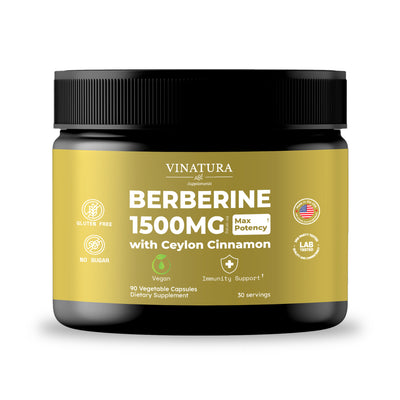
Echinacea and Goldenseal Root Benefits - Can We Combine Them?
Echinacea and Goldenseal root are two plants with amazing health benefits. The combination of these two has been widely studied and shown to be beneficial in boosting the immune system, treating infections, reducing inflammation, and providing relief for cold and flu symptoms. They have been used in traditional medicine for centuries and are now more commonly found in supplement form. Let's explore in detail this dynamic duo's benefits and how to take Echinacea and Goldenseal root effectively!
Before exploring further, please read the disclaimer located at the end of this webpage.
Echinacea Overview
Echinacea, also known as purple coneflower, is a herbaceous flowering plant native to North America. It has been used in Native American traditional medicine for centuries to treat various ailments including wounds, burns, and insect bites. The roots, leaves, and flowers of the plant are used for medicinal purposes.

Echinacea Features
- Purple coneflower appearance: Echinacea plants have tall stems with large, cone-shaped flowers in shades of pink, purple, and white.
- Easy to grow: Echinacea is a hardy plant that can thrive in most climates and soil types. It's also low maintenance and highly drought-resistant.
- Active compounds: The main active compounds found in Echinacea are flavonoids, caffeic acid derivatives, essential oils, and polysaccharides, which possess strong antioxidant and anti-inflammatory properties.
Echinacea Benefits
- Boosts the immune system [1] [2]: Echinacea is most commonly used to strengthen the immune system and prevent infections. Studies have shown that it can increase the production of white blood cells, which defend against viruses and bacteria.
- Reduces inflammation and antioxidant properties [1] [3]: Due to its anti-inflammatory properties, Echinacea is effective in reducing inflammation caused by conditions such as arthritis, bronchitis, and sinusitis.
- Reduces respiratory infections [1] [2]: Echinacea is effective in treating upper respiratory infections such as the common cold and flu. It can help reduce the severity of symptoms and shorten the duration of illness.
Goldenseal Root Overview
Goldenseal root, also known as orange root or yellow puccoon, is a perennial herb native to North America. It has been used in traditional medicine by Native American tribes for various purposes including treating digestive issues and skin infections.

Goldenseal Root Features
- Orange root appearance: Goldenseal plants have small, trumpet-shaped flowers that are greenish-white in color. They have large, lobed leaves and produce a bright yellow-orange root.
- Native American traditional use: Goldenseal has been used by Native American tribes as a medicinal herb for centuries. It was considered a sacred plant and was often referred to as the "king of the mucus membranes" due to its ability to treat respiratory infections.
- Active compounds: The main active compounds found in Goldenseal root are berberine, hydrastine, and canadine, which have antimicrobial and anti-inflammatory properties.
Goldenseal Root Benefits
- GI tract health [5] [6] [7]: Goldenseal has been traditionally used to treat digestive issues such as diarrhea, constipation, and stomach ulcers. It is believed to stimulate the production of digestive enzymes and reduce inflammation in the GI tract.
- Skin health [5]: Due to its antimicrobial properties, Goldenseal is often used topically to treat skin infections such as eczema, psoriasis, and acne. It can also help with wound healing and reduce skin irritation.
- Immune support [7]: Similar to Echinacea, Goldenseal is known for its ability to boost the immune system and prevent infections. It has been shown to increase white blood cell production and fight against harmful bacteria and viruses.
- Respiratory health [6] [7]: Goldenseal has a long history of being used to treat respiratory infections such as bronchitis and sinusitis. It can help reduce inflammation in the respiratory tract, making it easier to breathe.
For more information about Goldenseal root benefits and how to use it, take a look at this video:
Apart from the aforementioned primary benefits, Goldenseal root has been the subject of studies that have highlighted additional potential advantages.
These include antibacterial properties for eye health, relief from cold and flu symptoms, detoxification, urinary tract infection management, diabetes control, regulation of cholesterol levels, and potential effectiveness against Chlamydia or herpes. However, further research is necessary to validate these potential benefits.
Echinacea And Goldenseal Root Benefits
The use of natural herbal remedies is now widely encouraged as a healthier alternative to chemical compounds, owing to their significant health benefits. Among these remedies, Echinacea and Goldenseal Root have garnered attention in both studies and historical practices.
While the safety and effectiveness of combining these two herbs are still a topic of debate and uncertainty, it is becoming increasingly common to see them used together.
While numerous studies have highlighted the individual benefits and safety of Echinacea and Goldenseal Root, there is a relative scarcity of research specifically examining the combination of these two herbal ingredients.
Some studies suggest that certain compounds found in both herbs, such as berberine, polybutylamide, polyacetylenes, cichoric acid, and polysaccharides, may stimulate and enhance the immune system, as well as possess antiviral properties.
One notable study conducted by Jalees Rehman and colleagues investigated the effects of combining Echinacea angustifolia and Goldenseal in mice.
After six weeks of administration, significant improvements in immune function were observed, attributed to the increased production of antigen-specific immunoglobulins G and M [8].
Another study compared the efficacy of Goldenseal Root (H. canadensis) to a combination formula known as HMPE (Hydrastis canadensis, Commiphora habessinica, Phytolacca americana, and Echinacea purpurea).
The study found that Goldenseal Root alone exhibited greater antibacterial activity compared to HMPE [9].

In light of these studies, it remains challenging to definitively conclude whether the combination of Echinacea and Goldenseal Root enhances their effectiveness.
However, numerous functional food products on the market combine these two ingredients and have received approval for use.
Additionally, traditional medicine has a long history of widely using both herbs in combination, attributing many potential benefits to their synergistic effects. In fact, a 1996 survey identified Goldenseal and Echinacea, alongside garlic, as the top-selling products.
Their antimicrobial, anti-inflammatory, antispasmodic, and immune-stimulating properties have been highly acclaimed, particularly when used in combination [10].
Therefore, determining the safety and efficacy of combining Echinacea and Goldenseal Root is not a simple matter of yes or no. As mentioned earlier, there is a prevalence of functional food products that blend these two ingredients, and they have received authorization and regulation from relevant authorities.
However, it is important to note that Echinacea has not obtained FDA approval for use as a pharmaceutical drug.
Nonetheless, due to the limited scope of research, it's crucial to consider how to use them and be mindful of potential side effects. Therefore, let's explore the practical aspects of their usage and the potential side effects to keep in mind.
Possible Echinacea And Goldenseal Root Side Effects
The incorrect or excessive usage of the combined herbs may result in different side effects associated with each herb. The specific undesirable effects depend on the ratio of ingredients in the combination. Both research and practical reports have documented certain side effects related to the two herbs we have synthesized below.
Echinacea Side Effects
- Skin rash [11] [12]: One potential side effect of Echinacea usage is skin irritation, leading to the development of a rash. This may occur when used topically or taken orally.
- Allergic reactions [11] [12]: Some individuals may experience an allergic reaction to Echinacea, resulting in symptoms such as hives, difficulty breathing, and swelling of the tongue and throat.
- Gastrointestinal upsets [11] [12]: Echinacea may cause gastrointestinal side effects in certain individuals, such as nausea, vomiting, and stomach discomfort.

Goldenseal Root Side Effects
- Interactions with medications: Goldenseal Root contains compounds that may interfere with the metabolism of certain medications, leading to potential interactions and adverse effects.
- Disruption of gut flora: Goldenseal roots may have antibacterial properties that can disrupt the balance of good and bad bacteria in the gut, potentially leading to digestive upset.
- High doses may cause toxicity: Taking high doses of Goldenseal Root for extended periods may result in toxicity, causing symptoms such as nausea, vomiting, and liver damage.
While these side effects are not an exhaustive list, they demonstrate the importance of using herbal remedies with caution and under the guidance of a healthcare professional.
Consultation with a doctor or registered herbalist is recommended before consuming Echinacea and Goldenseal Root individually or in combination.
The lack of regulation and research in this area may make it difficult to determine the appropriate dosage and duration for optimal results while minimizing side effects. Therefore, it is essential to buy products from reputable sources and follow dosage instructions carefully.
How To Use Echinacea And Goldenseal Root?
Echinacea and Goldenseal Root can be consumed in various forms, including tablets, capsules, tinctures, teas, and extracts. The appropriate form depends on the individual's preference and desired effects.
When using Echinacea as a preventive measure against colds and flu, it is recommended to take it for 10-14 days at a time with an equal break in between. It may be taken for up to 8 weeks total, with a two-week break after each cycle.
Goldenseal Root can be taken daily as a general immune booster or used for acute conditions, such as infection. However, it is essential to follow recommended dosages and not exceed the 2g per day limit.
Conclusion
The combination of Echinacea and Goldenseal Root has been widely studied and used in traditional medicine for its potential immune-boosting and antiviral properties. While research on the efficacy and safety of combining these two herbs is ongoing, their use should be approached with caution. Consultation with a healthcare professional is recommended to determine the appropriate dosage and form, as well as to monitor for potential side effects. As with any herbal remedy, it is essential to source products from reputable sources and follow dosage instructions carefully for optimal results.
Frequently Asked Questions
Echinacea And Goldenseal Root - What’s Better?
Both Echinacea and Goldenseal Root offer unique benefits, and their efficacy depends on the health issue in question. However, they are often combined in traditional medicine to leverage their potential synergistic effects. Consulting a healthcare professional can provide personalized advice based on individual health needs.
Is It Safe To Consume Echinacea And Goldenseal?
While both Echinacea and Goldenseal Root are generally safe for most people, their combined use should always be under the guidance of a healthcare professional. Potential side effects and interactions with other medications need to be considered. Moreover, each individual's health condition and tolerance also play a key role in determining safety.
When Is The Best Time To Take Echinacea And Goldenseal?
The best time to take Echinacea and Goldenseal varies based on individual health needs and the advice of a healthcare professional. Typically, they are taken at the first sign of illness or as a preventive measure during cold and flu season. Always follow the dosage instructions provided on the product or by your healthcare provider.
How Often Should I Take Them?
The frequency of taking Echinacea and Goldenseal Root depends on the specific health concern and individual needs. As a general rule, for preventive measures, Echinacea can be taken for 10-14 days with an equal break in between, while Goldenseal Root should not exceed the 2g per day limit.
Who Should Avoid Echinacea And Goldenseal?
Individuals with allergies to plants in the daisy family should avoid Echinacea. Goldenseal should be avoided by those with high blood pressure, heart disease, or liver disease. Children, Pregnant and breastfeeding women should also refrain from using both herbs.
References
- [1] Kumar Blesso, & Sudha Ramaiah. (2011, December 25). International Journal of Pharma and Bio Sciences PHARMACOLOGICAL IMPORTANCE OF ECHINACEA PURPUREA. ResearchGate; unknown. https://www.researchgate.net/publication/262913970_International_Journal_of_Pharma_and_Bio_Sciences_PHARMACOLOGICAL_IMPORTANCE_OF_ECHINACEA_PURPUREA
- [2] Barrett, B. (2003). Medicinal properties of Echinacea: A critical review. Phytomedicine, 10(1), 66–86. https://doi.org/10.1078/094471103321648692
- [3] Yu, D., Yuan, Y., Jiang, L., & Xie, Z. W. (2013, March). Anti-inflammatory effects of essential oil in Echinacea purpurea L. ResearchGate; Faculty of Pharmacy and Pharmaceutical Sciences, University of Karachi. https://www.researchgate.net/publication/235776248_Anti-inflammatory_effects_of_essential_oil_in_Echinacea_purpurea_L?enrichId=rgreq-fe73659522a48dac15707982b5e0a8ff-XXX&enrichSource=Y292ZXJQYWdlOzIzNTc3NjI0ODtBUzo0ODQxMjg3MzU5MjgzMjFAMTQ5MjQzNjY5MzIzMA%3D%3D&el=1_x_3&_esc=publicationCoverPdf
- [4] Azadeh Manayi, Mahdi Vazirian, & Soodabeh Saeidnia. (2015). Echinacea purpurea: Pharmacology, phytochemistry and analysis methods. Pharmacognosy Reviews, 9(17), 63–63. https://doi.org/10.4103/0973-7847.156353
- [5] Sudip Kumar Mandal, Maji, A. K., Mishra, S., Pir Mohammad Ishfaq, Hari Prasad Devkota, A. Sanches-Silva, & Das, N. (2020). Goldenseal (Hydrastis canadensis L.) and its active constituents: A critical review of their efficacy and toxicological issues. Pharmacological Research, 160, 105085–105085. https://doi.org/10.1016/j.phrs.2020.105085
- [6] Bharathi Avula, Wang, Y. H., Smillie, T. J., & Khan, I. A. (2009). Extraction and Analysis of Alkaloids from Roots of Goldenseal and Dietary Supplements by Using UPLC-UV-MS Methods. Planta Medica, 75(04). https://doi.org/10.1055/s-2009-1216507
- [7] Immune Modulation of Macrophage Pro-Inflammatory Response by Goldenseal and Astragalus Extracts | Journal of Medicinal Food. (2021). Journal of Medicinal Food. https://www.liebertpub.com/doi/abs/10.1089/jmf.2008.0044
- [8] Rehman, J., Dillow, J. M., Carter, S. M., Chou, J., Le, B., & Maisel, A. S. (1999). Increased production of antigen-specific immunoglobulins G and M following in vivo treatment with the medicinal plants Echinacea angustifolia and Hydrastis canadensis. Immunology Letters, 68(2-3), 391–395. https://doi.org/10.1016/s0165-2478(99)00085-1
- [9] Effects of Hydrastis Canadensis, Commiphora Habessinica, Phytolacca Americana, and Echinacea Purpurea on Bacterial Growth - ProQuest. (2021). Proquest.com. https://www.proquest.com/openview/a65dd19d9c035535bcd10181b075d240/1?pq-origsite=gscholar&cbl=32528
- [10] Mahady, G. B., & Chadwick, L. R. (2001). Goldenseal (Hydrastis canadensis): Is There Enough Scientific Evidence to Support Safety and Efficacy? Nutrition in Clinical Care, 4(5), 243–249. https://doi.org/10.1046/j.1523-5408.2001.00004.x
- [11] Huntley, A., J Thompson Coon, & Ernst, E. (2005). The Safety of Herbal Medicinal Products Derived from Echinacea Species. Drug Safety, 28(5), 387–400. https://doi.org/10.2165/00002018-200528050-00003
- [12] Ardjomand‐Woelkart, K., & Bauer, R. (2015). Review and Assessment of Medicinal Safety Data of Orally Used Echinacea Preparations. Planta Medica, 82(01/02), 17–31. https://doi.org/10.1055/s-0035-1558096
Author

Product Disclaimer
Including an ingredient or study does not evaluate, endorse, or recommend any Vinatura product or any third-party product. Some ingredients discussed may not be used in any Vinatura product.
The content of the articles has not been evaluated by the Food and Drug Administration (FDA) and is not intended to promote or endorse any specific product. Any products sold on this website are not intended to diagnose, treat, cure, or prevent any disease.
Opinions and Endorsements
Any claims, statements, or opinions expressed in the articles are those of the author(s) and do not necessarily reflect the views or opinions of the manufacturers of the dietary supplement products. The products sold on this website are separate from the content of the articles and are not directly endorsed or associated with the information presented here.
Liability Disclaimer
The author(s) of the articles, website, and manufacturers of the dietary supplement products do not assume any liability for any potential consequences arising from the use of the information provided in the articles. Ingredient effects, dosages, and safety vary by individual, formulation, and context; some ingredients interact with medications or may be unsuitable during pregnancy or lactation. It is recommended that individuals consult with a qualified healthcare professional before making any dietary or lifestyle changes, including the use of dietary supplements.
Product Usage
Please refer to the product labels and packaging for specific usage instructions and guidelines for the dietary supplement products sold on this website.
Customer Support
For any concerns or questions regarding the dietary supplement products, please contact our customer support team, who will be more than happy to assist you.





Leave a Comment
Be the first to comment.
What do you think?